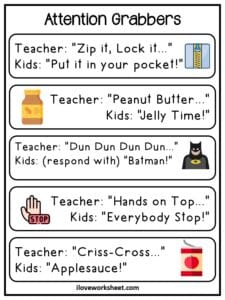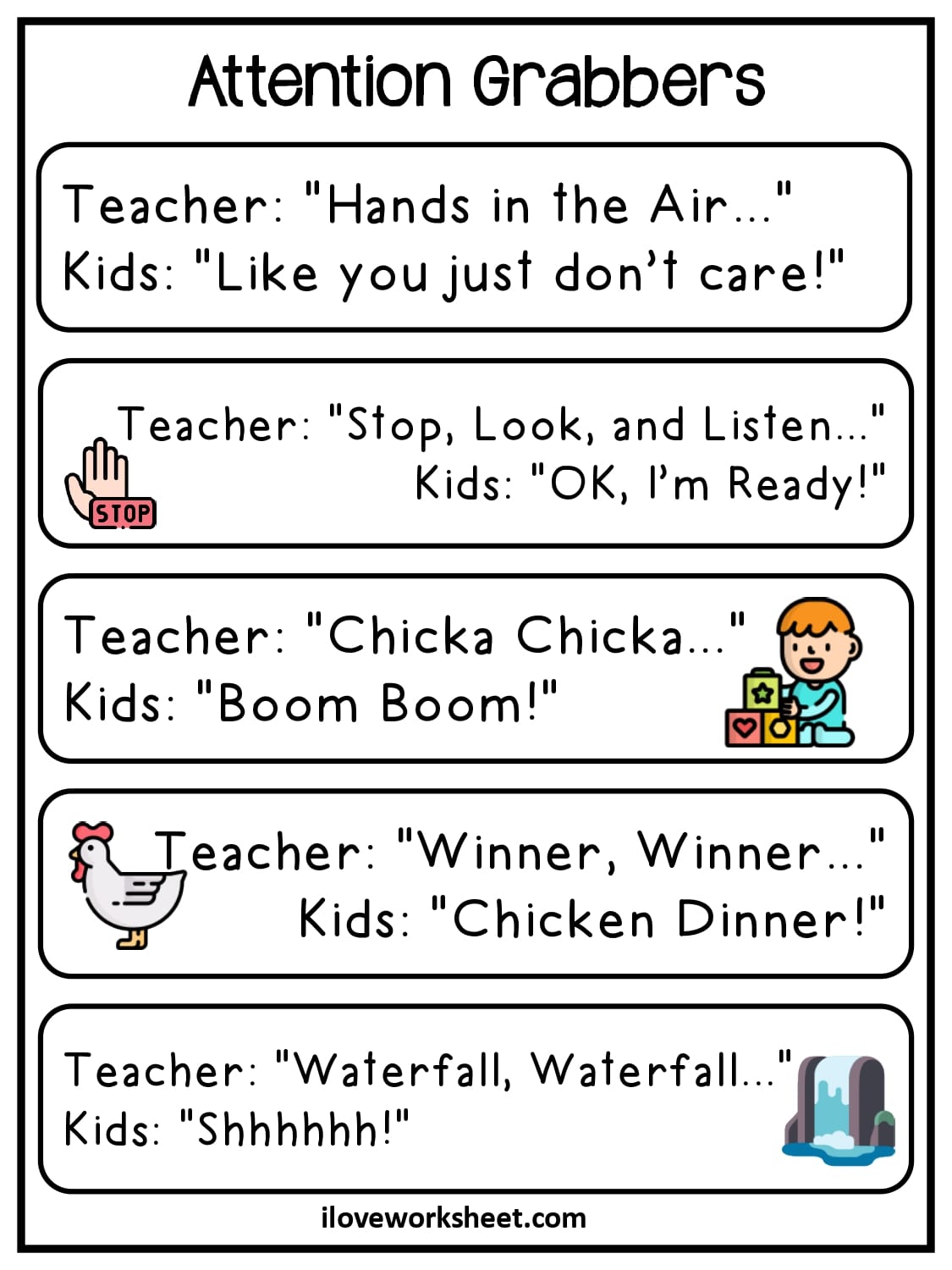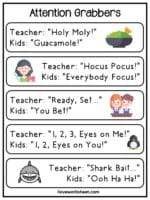Kindergarten Classroom Attention Grabbers Free PDF
Kindergarten Attention Grabbers in the Classroom: Strategies to Keep Young Learners Engaged
Capturing the attention of kindergarten students can be both a challenge and an opportunity for teachers. At this age, children are full of energy and curiosity, but their attention spans can be short. Effective attention grabbers are key to creating a productive learning environment. This article explores various techniques, activities, and ideas for attention grabbers that work wonders in the kindergarten classroom.

Why Are Attention Grabbers Important in Kindergarten?
Attention grabbers are not just tools to quiet a noisy room; they play a vital role in classroom management and learning. Here’s why they are essential:
- Focus and Engagement
They help direct young learners’ attention to the teacher or the task at hand. - Smooth Transitions
Moving between activities can be chaotic; attention grabbers create order. - Boosting Participation
Interactive attention grabbers encourage children to actively engage with lessons. - Fostering Fun and Connection
Fun attention grabbers create a positive classroom atmosphere, making learning enjoyable.
Types of Kindergarten Attention Grabbers
There’s no one-size-fits-all solution for capturing attention. Here are some types of attention grabbers that work particularly well with kindergarteners:
- Call and Response
- Teacher: “1, 2, 3, eyes on me!”
- Students: “1, 2, eyes on you!”
- Clapping Patterns
Clap a simple pattern and have students repeat it. - Songs and Chants
- Example: “If you can hear me, clap your hands!”
- Incorporating tunes from familiar nursery rhymes can make this more effective.
- Funny Attention-Getters
- “Hocus Pocus!” (Students respond: “Everybody focus!”)
- “Macaroni and cheese!” (Students respond: “Everybody freeze!”)
- Visual Cues
- Raise a hand or use a fun prop like a wand or a puppet.



Using Movement as an Attention Grabber
Movement-based attention grabbers are particularly effective for young children who are naturally energetic. Here are some ideas:
- Freeze Dance
Play a song and have students dance. When the music stops, they freeze in place. - Simon Says
This classic game not only grabs attention but also improves listening skills. - Stretch and Wiggle
Lead students in quick movements like stretching, hopping, or wiggling to reset their focus. - Follow the Leader
Start doing an action (e.g., tapping your head) and ask students to mimic you.
Incorporating Visual Attention Grabbers
Sometimes, a visual element can work better than verbal cues. Here are some ways to grab attention visually:
- Colorful Signs or Cards
Use brightly colored signs with messages like “Quiet Time” or “Look Here.” - Flashlights or Glow Sticks
Dim the lights and use a flashlight or glow stick to signal attention. - Costumes or Hats
Wearing a funny hat or costume can instantly grab students’ attention.
Attention Grabbers for Transitions
Transitioning between activities or subjects can be tricky, but these strategies can make it smoother:
- Countdowns
Use a countdown (e.g., “5, 4, 3, 2, 1, pencils down!”) to signal the end of an activity. - Mystery Box
Hold up a box and say, “What’s inside? I’ll tell you once everyone is seated!” - Transition Songs
Sing a short tune like:“Clean up, clean up,
Everybody, everywhere!
Clean up, clean up,
Time to put your things away!”
The Role of Technology in Attention Grabbers
Technology can be a valuable ally in grabbing attention. Here’s how to use it effectively:
- Interactive Whiteboards
Use engaging animations or games to focus attention. - Sound Effects
Play a sound (like a bell or animal noise) as an auditory cue. - Short Videos
Show a quick educational clip to reset attention.
Tips for Creating Effective Attention Grabbers
Designing and delivering attention grabbers requires some creativity and planning. Here are tips to ensure they work effectively:
- Be Consistent
Use the same attention-grabbing technique regularly so students know what to expect. - Match the Activity
Choose attention grabbers that align with the tone of the next activity. - Keep It Short
Attention grabbers should be quick and to the point, lasting no more than 30 seconds. - Use Humor and Enthusiasm
A cheerful, animated delivery makes attention grabbers more effective.
Examples of Fun Attention Grabbers
Here are some tried-and-tested attention grabbers that kindergarten teachers swear by:
- The Quiet Coyote
Hold up your hand in a coyote shape (thumb and pinky extended). Tell kids the coyote is quiet, and they should be too. - Magic Words
- Teacher: “Abracadabra!”
- Students: “Focus on me!”
- Animal Sounds
Make a funny animal noise, like a lion’s roar or a bird’s chirp, to grab attention. - Story Starters
Say, “Once upon a time…” and pause. Kids will quiet down, eager to hear the story.
The Power of Positive Reinforcement
Combining attention grabbers with positive reinforcement can amplify their effectiveness. Here’s how:
- Praise Good Behavior
Recognize students who respond quickly to attention grabbers.“I love how Sara and Ben are sitting quietly!”
- Reward Systems
Use stickers or a classroom rewards chart to encourage participation.
Attention Grabbers That Foster Classroom Community
Attention grabbers can also double as opportunities to build a sense of community:
- Morning Greeting Chant
- Teacher: “Good morning, everyone!”
- Students: “Good morning, [teacher’s name]!”
- Class Pledge
Recite a simple, positive class pledge together to start the day. - Buddy System
Pair students and let them take turns leading attention grabbers.
Troubleshooting Common Challenges
Even the best attention grabbers can fall flat sometimes. Here’s how to troubleshoot common issues:
- Too Much Noise?
Introduce a visual cue like turning off the lights momentarily. - Lack of Participation?
Add variety to keep attention grabbers fresh and exciting. - Overuse of One Technique?
Rotate between different attention grabbers to maintain novelty.
Attention grabbers are a powerful tool in the kindergarten classroom, helping teachers create an engaging and focused learning environment. By using a mix of call-and-response phrases, movement-based activities, visual cues, and technology, teachers can keep young learners interested and excited to learn.
Download Classroom Attention Grabbers Free PDF
The key is to make these attention grabbers fun, consistent, and tailored to the classroom’s unique energy. With these strategies, grabbing and holding the attention of your kindergarteners can become a delightful part of your teaching routine.















